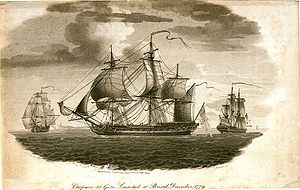HMS Cleopatra (1779)

HMS Cleopatra, depicted in a print by Nicholas Pocock
|
|
| History | |
|---|---|
|
|
|
| Name: | HMS Cleopatra |
| Ordered: | 13 May 1778 |
| Builder: | James Martin Hillhouse, Bristol |
| Laid down: | 6 July 1778 |
| Launched: | 26 November 1779 |
| Completed: | By 9 September 1780 |
| Fate: | Broken up by 21 September 1814 |
| Notes: |
|
| General characteristics | |
| Class and type: | 32-gun Amazon-class fifth rate frigate |
| Tons burthen: | 689 17/94 bm |
| Length: |
|
| Beam: | 35 ft 2.5 in (10.7 m) |
| Depth of hold: | 12 ft 1.75 in (3.70 m) |
| Propulsion: | Sails |
| Sail plan: | Full rigged ship |
| Complement: | 220 |
| Armament: |
|
HMS Cleopatra was a 32-gun Amazon-class fifth rate frigate of the Royal Navy. She had a long career, seeing service during the Fourth Anglo-Dutch War, and the French Revolutionary and Napoleonic Wars. During the latter wars she fought two notable engagements with larger French opponents. In the first engagement she was forced to surrender, but succeeded in damaging the French ship so badly that she was captured several days later, while the Cleopatra was retaken. In the second she forced the surrender of a 40-gun frigate. After serving under several notable commanders she was broken up towards the end of the Napoleonic Wars.
Cleopatra was ordered on 13 May 1778 and was laid down on 6 July 1778 at the yards of James Martin Hillhouse, Bristol. She was launched on 26 November 1779 and had been completed by 9 September 1780. £9,202 (approximately £1.1 million at today's prices)was paid to the builder, with another £5,563.1.5d (approximately £670 thousand at today's prices)spent on dockyard expenditures.Cleopatra was commissioned in October 1779 under her first commander, Captain George Murray.
Cleopatra was initially assigned to serve with the Western squadron and was soon active in activities to suppress French cruisers and privateers. On 15 June 1780 Cleopatra and HMS Apollo captured the 26-gun Stanisland off Ostend; while the privateer Comtesse de Provence fell to Cleopatra on 11 November 1780.Cleopatra escorted a convoy to the Baltic on 1781, becoming involved in the Battle of Dogger Bank on 5 August. She passed under the command of Captain Henry Harvey in January 1783, but was paid off in April that year and fitted for ordinary at Sheerness. She remained laid up until 1790 when she began a Great Repair, and was recommissioned in January 1793 under Captain Alexander Ball.
...
Wikipedia
